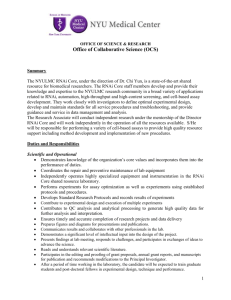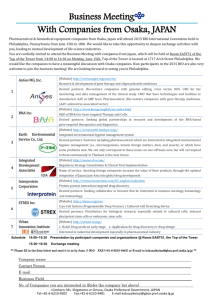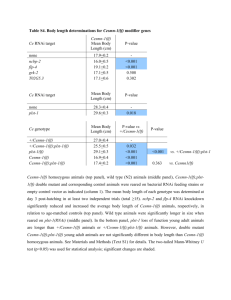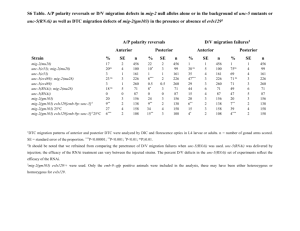The Future of Research and Development RIETI Policy Symposium
advertisement
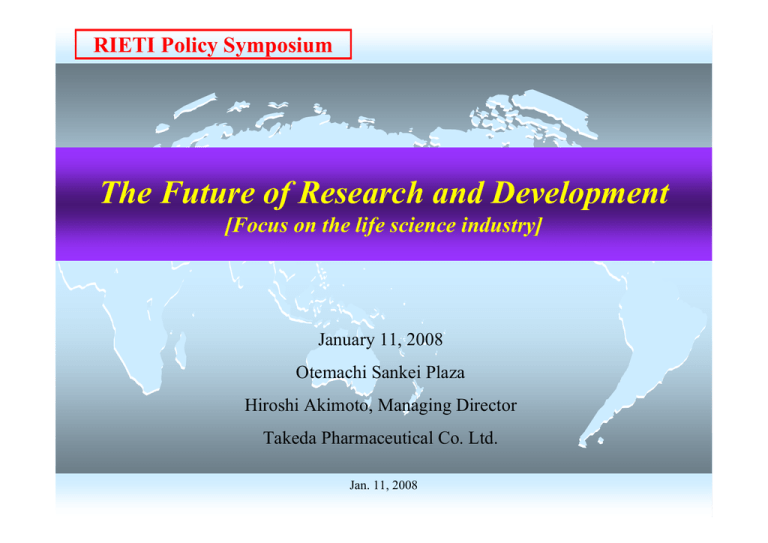
RIETI Policy Symposium The Future of Research and Development [Focus on the life science industry] January 11, 2008 Otemachi Sankei Plaza Hiroshi Akimoto, Managing Director Takeda Pharmaceutical Co. Ltd. Jan. 11, 2008 R&D, intellectual property and human resources in the life science industry 15-17 years 2-3 years 2-4 years 3-5 years 3-7 years 1-2 years Downstream Upstream Drug discovery stage Analysis of gene functions Screening of candidate compounds for drug development 1/30,000 Animal testing Human clinical trials Application for approval Drug released onto market 1/6,000 1 1/5 (1/10) R&D costs: 20-50 billion yen (up to 100 billion yen) Upstream: Gene, research tool and screening patents Midstream: Substance, formula, application and pharmaceutical patents Downstream: Combined usage and combination patents, design trademarks After release: Reexamination period, LCM patents Individuals 0⇒1 Culture? Human resources? Systems 1⇒10 Speed Organizations 10⇒100 100⇒1000 - Top 20 Global R&D Spenders, 2006 Jan. 11, 2008 3 The global pharmaceutical market – now and in the future Japan’s share of the global market is on the decline and is set to dip below 10%. N. America Others 34% Japan 21% 252 Bill $ 27% 2005 45% 30% Europe 29% ○ Issues 26% 27% 27% 32% 1995 2004 Europe 46% Source: IMS World Review, IMS Market Prognosis N. America 29% 2009 806 Bill $ Europe Share of regional GDP Japan 18% 9% 605 Bill $ Europe Others 16% Japan 11% 1994 N. America Others 14% 18% Japan N. America Others 11% 30% Source: Main Economic Indicators of Selected Countries, Ministry of Internal Affairs and Communications Statistics Bureau (1995 shares estimated based on relevant data) ● Strengthening R&D capabilities first and foremost to fulfill role as core industry under Innovation 25 ● Determining how to help control increases in medical costs and maintain and improve QOL in an aging society Developing groundbreaking new drugs Jan. 11, 2008 4 Presence of pharmaceutical industry in overseas markets Fiscal year 1997 2002 2006 Overseas sales (million yen) 297,249 13 companies 1,360,367 30 companies 2,454,792 Top 19 companies Percentage of consolidated sales (%) 10.6 28.5 37 Sources: For 1997 and 2002 figures, Data Book 2004, Japan Pharmaceutical Manufacturers Association (JPMA) For 2006 figures, International Drug Bulletin June 11, 2007 issue Jan. 11, 2008 5 Presence of pharmaceutical industry in overseas markets 3,000,000 40 35 2,500,000 30 2,000,000 25 Overs eas s ales (million yen) 1,500,000 20 Percentage of cons olidated s ales (%) 15 1,000,000 10 500,000 5 (million yen) (%) 0 0 1997 2002 2006 Sources: For 1997 and 2002 figures, Data Book 2004, Japan Pharmaceutical Manufacturers Association (JPMA) For 2006 figures, International Drug Bulletin June 11, 2007 issue Jan. 11, 2008 6 Worldwide ranking of drugs originating from Japan Position Brand Manufacturer Worldwide sales (million $) 13 Takepron (ulcers) Takeda 4,170 19 Actos (diabetes) Takeda 3,275 26 Blopress (antihypertensive) Takeda 2,842 29 Cravit (antibiotic) Daiichi/Sankyo 2,740 31 Pariet (ulcers) Eisai 2,703 34 Aricept (Alzheimer’s) Eisai 2,483 40 Harnal (prostatic hyperplasia) Astellas 2,284 42 Crestor (hyperlipidemia) Shionogi 2,212 49 Mevalotin (hyperlipidemia) Daiichi/Sankyo 1,983 50 Leuplin (prostate cancer) Takeda 1,981 51 Abilify (schizophrenia) Otsuka 1,972 58 Epogin (renal anemia) Chugai 1,827 71 Prograf (immunosuppresant) Astellas 1,474 78 Olmetec (antihypertensive) Daiichi/Sankyo 1,392 Items originating from Japan (14 items) 33,338 Items with sales of 1,300 million dollars or more (85 items) 230,781 Japan’s share (16.5 %) 14.4 % Jan. 11, 2008 Source: Pharma Future, July 2007 7 * Worldwide sales include sales on overseas export markets Attitudes towards inventions at drug-discovery pharmaceutical companies (JPMA 2007 survey findings) - Attitudes and underlying feelings amongst life science researchers [Attitude] Want to invent groundbreaking drugs and make a contribution to the company and society as a whole [Underlying feelings] Want to see more credit given to inventors for their achievements (contributions) - Attitudes, underlying feelings and preferences within the life science (pharmaceutical) industry [Attitudes towards inventors] - Want inventors to play a prominent role and develop as many hit products as possible in the interests of corporate development - Companies also want to back up such activities [Underlying feelings within industry] - With such intense global competition just to stay afloat, companies can’t afford to fight it out over lawsuits involving employee inventions - Inventors and companies should work together to survive within a difficult R&D environment [Preferences regarding jurisdiction over final decisions on the value of inventions] - Want recognition of the fact that companies face different risks to other industries in view of the rapidly growing array of obstacles making it difficult for drug-discovery pharmaceutical companies to sustain their business models (development periods, development costs, probability of success, etc.) - Want balance between inventor rewards and the company’s contribution in bringing the product to market to be taken into account - Want values to be calculated appropriately, taking into account the new Article 35 of the Patent Act when applying the former Article 35 Jan. 11, 2008 8 What next !? Emerging technologies ?? Genomic drug discovery Biologics Antibodies, vaccines Genetic drug discovery New drug development Collaboration between engineering, medicine and pharmacology Nucleic medicine Regenerative medicine Jan. 11, 2008 9 The secret to collaboration between industry, academia and government based on successful examples ~ Academic-led collaboration ~ Progress is being made with collaboration spearheaded by universities and research institutes in the Japan-dominated field of sugar chain research. Plan to support development of new industries harnessing the functions of sugar chains (2002-) Hitachi Housetec Hokkaido University Kyoto University Osaka University Kyowa Hakko Development of automatic sugar chain synthesis apparatus RIKEN Shionogi Development of diabetes medication ⇒ Potelligent technology (licensed to six companies) Osaka University-Kyowa Hakko: Development of next-generation antibody drugs through sugar chain regulation Integration and development of Osaka University’s sugar chain modification technology and Kyowa Hakko’s increased antibody activity technology proposed by Osaka University Hokkaido University-Hitachi Housetec-Shionogi: Establishment of a center for future drug discovery and medical innovation Application of Hokkaido University’s automatic sugar chain synthesis technology for the purpose of drug discovery and subsequent commercialization proposed to partner companies Need to actively disseminate information to link “seeds” and “needs” Jan. 11, 2008 10 The secret to collaboration between industry, academia and government based on successful examples ~ Industry-led collaboration ~ Actemra, Japan’s first IL-6 inhibiting antibody drug, was developed over the course of two decades based on an effective combination of Osaka University’s research results and Chugai Pharmaceutical’s technical capabilities. 1984 Chugai commences IL-6 pharmaceutical research 2006 Chugai files application for Actemra as a drug to treat rheumatoid arthritis 2005 Chugai releases Actemra as a drug to treat Castleman’s disease 1986 Osaka University succeeds in cloning IL-6 genes 2000 Chugai commences clinical trials on Castleman’s disease 1986 Chugai & Osaka University commence joint research into IL-6 inhibitor development 1987 Osaka University identifies IL-6 receptor 1988 1996 Osaka University announces effectiveness of anti-IL-6 receptor against rheumatoid arthritis 1998-99 Chugai commences clinical trials on rheumatoid arthritis (in Japan and overseas) Osaka University produces anti-IL-6 receptor 1988-89 Chugai investigates humanized antibodies MRC (UK research institute) commences joint research into humanized antibody production technology 1990 Chugai successfully develops humanized anti-IL-6 receptor 11 Collaboration between industry, academia and government in the field of life sciences and its significance BV technical capabilities BV compounds University research results ndaries u o b e t a Corpor Pharmaceutical companies’ strengths (capabilities) Research Development Research, development, intellectual property, production, sales, management Source: Henry Chesbrough, “Open Innovation”, HBS Press The collaborative relationship between industry, academia and government in the field of life sciences Low absolute number “Angels” Increasing shortage of human resource exchange Companies Pension funds Institutional investors Funding No entry? Venture capital University researchers Commercialization/ Open market Bio-venture businesses Company workers, etc. Strict listing requirements (TSE Mothers, OSE Hercules) Few companies developing own platform technology Individual investors Support infrastructure Improving services from supporting specialists Source: Based on Bio-venture Management Theory, Hiroyuki Ozaki (partially amended) Pool of potential entrepreneurs Few people capable of mastering both business and technology E.g. Core RNAi* technology and its scope of application There are high hopes for the application of RNAi technology in the medical, chemical, agricultural, forestry and fisheries industries and other bio industries. Extensive work is currently underway on the development of core technology for the practical application of RNAi. * RNAi (RNA interference): Technology that uses short RNA duplexes to inhibit the expression of specific genes (Pharmaceutical/medical industry) RNAi medicine (Agriculture, forestry and fisheries) Breeding/modifying plants and animals (Chemical industry) Breeding hosts for substance production (Research support industry) - Reagents, kits - RNAi related commissioned research Core RNAi technology - siRNA design - RNAi installation technology - Assessment technology Dr. Fire & Dr. Mello, Nobel Prize winners in 2006 Discovery of RNAi phenomena in nematodes (1998) Stanford University University of Massachusetts Clarification of function of siRNA (2001) Max Planck Institute 14 Collaboration on core RNAi technology between industry and academia (and government) Originating from a number of pioneering US universities, including the University of Massachusetts, the Max Planck Institute and Stanford University, a robust framework of professional innovation has been built up through venture businesses into several mega pharmaceutical companies, as outlets for industrialization. Novartis GSK Merck & Co. Ambion Allergan Promega Nastech Alnylam QIAGEN Sirna Revivicor Benitec Columbia University siRNA targeting hair growth genes Stanford University In vivo RNAi technology Cancer Res. Tech. (TLO) RNAi technology on mammal cells University of Zurich Immune response induction RNAi motif Iowa University RNAi technology to treat neurological disorders University of Massachusetts Fire & Mello patents Cold Spring Harbor Laboratory RNAi technology on mammal cells Max Planck Institute siRNA related Tuschl patents Reference: FY2005 survey report on trends in technology subject to patent applications (Patent Office) 15 What does collaboration between industry, academia and government in the field of life sciences entail? Life science companies - Production of new drugs - Breeding/modifying plants and animals - Development of research support technology and tools Universities/ research institutes - TLO Law (1998) - Japanese Bayh-Dole Act (1999) - Comprehensive intellectual property strategy (2002) Government/ industrial policy - Clarification of disease mechanisms Discovery of target molecules Development of assessment technology Development of new models Basic research tools Basic research that is beyond the capabilities of companies is handled by universities and research institutes based on a range of policies (soil) aimed at promoting collaboration between industry and academia. Research results (seeds) are then nurtured by companies in order to produce drugs and other products (fruit). 16

